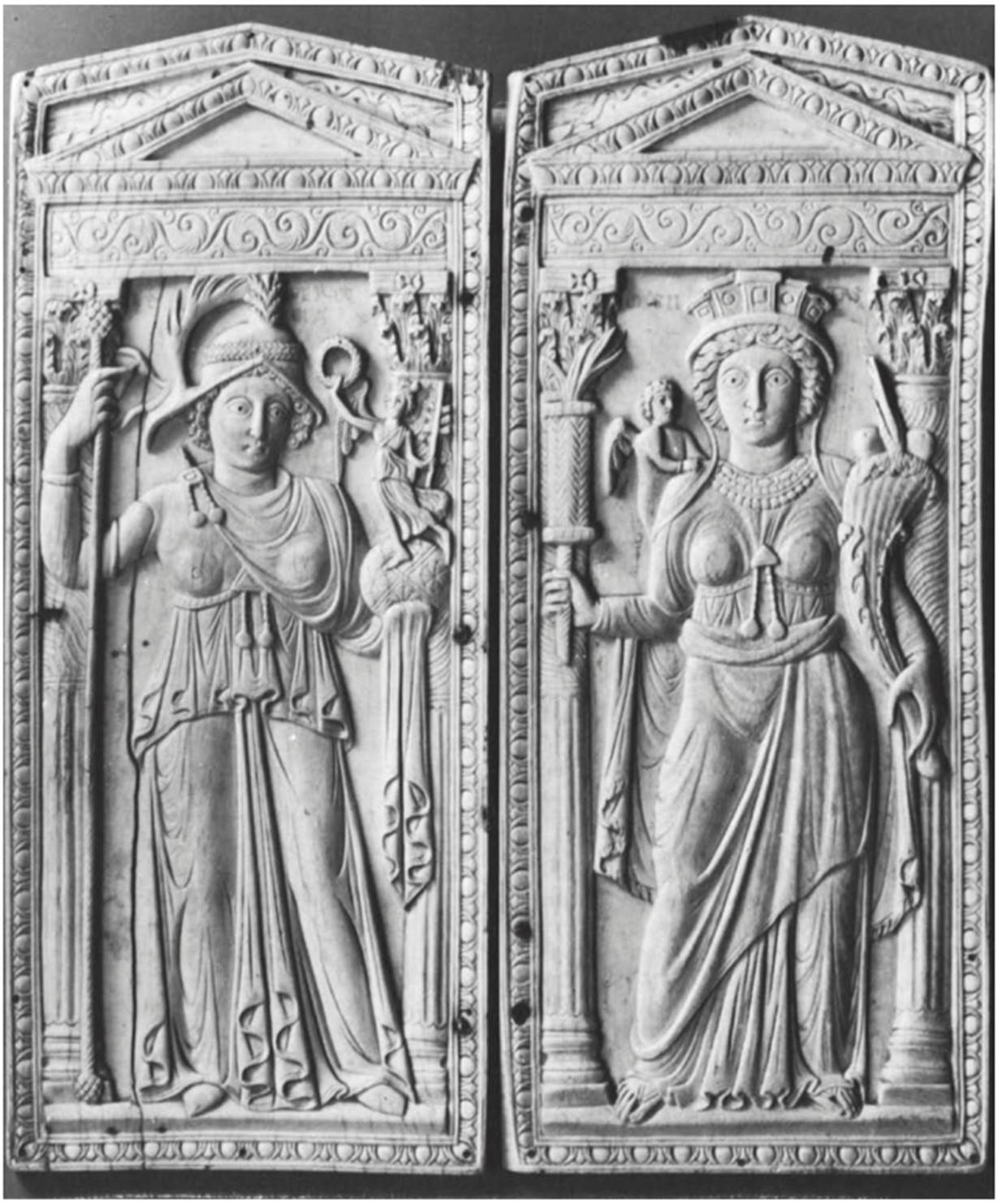Diptych with Roma and Constantinopolis. Constantinople (?), late 5th-early 6th century. Ivory
These diptych leaves were originally attached by metal hinges: rectangular recesses on the back received wax to be written upon with a stylus. The holes along the bottom, sides, and top were drilled at a later date, probably to mount the panels onto another object.
Each leaf is bordered by an egg-and-dart band that encloses an aedicula where stand personifications of the two great capitals, Rome and Constantinople. Roma is identified by the helmet and paludamentum. Her voluminous peplos is tied by a gem-studded belt below her breasts, leaving the right one bare. In her right hand she holds a staff, while her covered left supports an orb with a victoriola, offering Roma a laurel wreath and displaying a ship's prow (?).

Constantinopolis wears a veil, a high, jeweled mural crown, a three-stranded necklace, a long- sleeved tunic tied beneath her breasts by a belt exactly like that worn by Roma, and a palla around her hips. In her left hand she holds a cornucopia with fruit and grain and in her right a large cylindrical torch. A cupid clings to her right shoulder.
The surface is crowded with a variety of dense patterns: curls and waves in the hair, parallel or symmetrical drapery folds, zigzags on feathers and torch, and others. The contrapposto poses of the stocky figures are not confined in the aediculae, but overlap the columns, and appear awkwardly flattened. The artist has given up realistic spatial and corporeal relationships for a decorative and hieratic presentation.
The group of ivory diptychs to which this one belongs, made in the fifth and the sixth centuries, were used as prestigious gifts informing the recipient of some momentous occasion (cf. nos. 60, 165, 166). Delbrueck (1929, pp. 163-165) saw in the paraphernalia of Constantinopolis—veil, cupid, and torch—and Roma's staff with pine- cone (a thyrsus interpreted as an indirect Dionysiac reference) allusions to marriage. He cited the marriage in 467 of Alypia, daughter of the emperor Anthemius (467-472) to Ricimer as the most likely event symbolized by these figures. The consulate of Anthemius' son, Flavius Marcianus, in 469, he considered the actual occasion for the diptych.
No one has challenged this interpretation, although Weigand (1930-1931, p. 40) took exception to Delbrueck's (1929, p. 165) attribution of the piece to an Eastern artist working in Rome. Considering it of totally Western workmanship, all later scholars agreed with this revision (Peirce and Tyler, 1932, I, p. 82; Weitzmann [1], 1964, no. 31; Noll [1], 1974, nos. 17, 18; Volbach, 1976, no. 38). However, the pieces closest to these, considering carving technique, style, and spatial relationships, appear to date from the early sixth century, and to originate in the East—the Barberini equestrian (no. 28), the diptych of Magnus (no. 49), and the archangel Michael (no. 481). In view of these comparisons, and the cogent similarities between this diptych and another ivory plaque in Milan (Volbach, 1976, no. 49), a Constantino- politan origin, around 500, should now be considered more likely.
The painted inscriptions teperancia ("Temperance") and castitas ("Chastity") are later additions, perhaps as early as the eighth or ninth century. There are faint illegible traces of writing on the backs of both leaves.
First published in Florence (1753) in the Riccardi collection, it later appeared in an inventory (1821) in Vienna. Bibliography: Volbach, 1976, no. 38.
Date added: 2025-08-31; views: 77;
